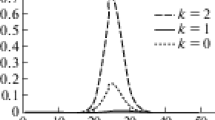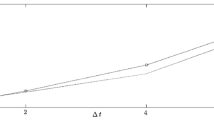Abstract
A practical implementation of the data assimilation algorithm based on the Kalman filter in its complete formulation is impossible due to high dimension of the associated equation sets and to nonlinearity of the predicted processes. The main direction in the implementation of the Kalman filter is an ensemble approach. Under the assumption of ergodicity of random forecast errors, an alternative algorithm with respect to the ensemble Kalman filter can be considered, in which probability averaging is replaced by time averaging. The proposes algorithm is based this assumption. The algorithm is easy to implement; however, its convergence, applicability to the data assimilation problems, and connection to the Kalman filter have not been studied. In the paper, applicability of the π-algorithm to data assimilation is considered on an example of a simple one-dimensional advection equation. Use of this simple equation allows comparing the classical Kalman filter algorithm with various practical approaches to its implementation.
Similar content being viewed by others
References
A. V. Balakrishnan, Kalman Filtering Theory (Mir, Moscow, 1988) [in Russian].
E. G. Klimova, “Algorithm for Data Assimilation Based on Adaptive Suboptimum Kalman Filter,” Meteorol. Gidrol., No. 3 (2005) [Russ. Meteorol. Hydrol., No. 3 (2005)].
E. G. Klimova, “An Asymptotic Behavior of Meteorological Data Assimilation Scheme Based on the Kalman Filter Algorithm,” Meteorol. Gidrol., No. 8 (1999) [Russ. Meteorol. Hydrol., No. 8 (1999)].
E. G. Klimova, “The Algorithm of Meteorological Data Assimilation Based on the Extended Suboptimal Kalman Filter,” Meteorol. Gidrol., No. 11 (1997) [Russ. Meteorol. Hydrol., No. 11 (1997)].
E. G. Klimova, “A Model to Calculate the Covariance of Homogeneous Isotropic Stochastic Fields of Forecast Errors,” Meteorol. Gidrol., No. 10 (2001) [Russ. Meteorol. Hydrol., No. 10 (2001)].
E. G. Klimova, “A Primitive-Equation Model for Calculation of Forecast Error Covariances in the Kalman Filter Algorithm,” Meteorol. Gidrol., No. 11 (2001) [Russ. Meteorol. Hydrol., No. 11 (2001)].
E. G. Klimova, “Simplified Models of Computation of the Covariance Matrices in the Kalman Filter Algorithm,” Meteorol. Gidrol., No. 6 (2000) [Russ. Meteorol. Hydrol., No. 6 (2000)].
E. G. Klimova, “Numerical Experiments on Meteorological Data Assimilation Using a Suboptimal Kalman Filter,” Meteorol. Gidrol., No. 10 (2003) [Russ. Meteorol. Hydrol., No. 10 (2003)].
A. A. Krasovskii, I. N. Beloglazov, and G. P. Chigin, Theory of Correlation-extreme Navigation Systems (Nauka, Moscow, 1979) [in Russian].
D. M. Sonechkin, “Dynamical-statistical Approach to the Problem of Objective Analysis of Heterogeneous Meteorological Observations,” Trudy Gidromettsentra SSSR, No. 181 (1976) [Trans. Hydrometeorological Res. Center of the USSR, No. 181 (1976)].
Reference Book on Automated Control, Ed. by A.A. Krasovskii (Nauka, Moscow, 1987) [in Russian].
A. M. Yaglom, Correlation Theory of Stationary Random Functions (Gidrometeoizdat, Leningrad, 1981) [in Russian].
M. Fisher and E. Andersson, Development in 4D-Var and Kalman Filtering, Technical Memorandum No. 357 (ECMWF, Reading, England, 2001).
A. H. Jazwinski, Stochastic Processes and Filtering Theory (Academic Press, New York, 1970).
P. L. Houtekamer and H. L. Mitchell, “Data Assimilation Using an Ensemble Kalman Filter Technique,” Mon. Wea. Rev., 126 (1998).
P. L. Houtekamer and H. L. Mitchell, “Ensemble Kalman Filtering,” Quart. J. Roy. Meteorol. Soc., 131 (2005).
M. Ghil and P. Malanotte-Rizzolli, “Data Assimilation in Meteorology and Oceanography,” Adv. Geophys., 33 (1991).
E. Kalnay, B. R. Hunt, E. J. Kostelich, et al., “Four-dimensional Ensemble Kalman Filtering,” Tellus, 56A (2004).
F. Rabier, P. Courtier, J. Pailleux, et al., “Comparison of Four-dimensional Variational Assimilation with Simplified Sequential Assimilation,” in Proc. of ECMWF Workshop “Variational Assimilation, with Special Emphasis on Three-Dimensional Aspects,” November 9–12, 1992.
O. Talagrand and P. Courtier, “Variational Assimilation of Meteorological Observations with the Adjoint Vorticity Equation. I: Theory,” Quart. J. Roy. Meteorol. Soc., 113 (1987).
R. Todling and S. Cohn, “Suboptimal Schemes for Atmospheric Data Assimilation Based on the Kalman Filter,” Mon. Wea. Rev., 124 (1996).
Author information
Authors and Affiliations
Additional information
Original Russian Text © E.G. Klimova, 2008, published in Meteorologiya i Gidrologiya, 2008, No. 3, pp. 16–26.
About this article
Cite this article
Klimova, E.G. A data assimilation technique based on the π-algorithm. Russ. Meteorol. Hydrol. 33, 143–150 (2008). https://doi.org/10.3103/S1068373908030023
Received:
Published:
Issue Date:
DOI: https://doi.org/10.3103/S1068373908030023




